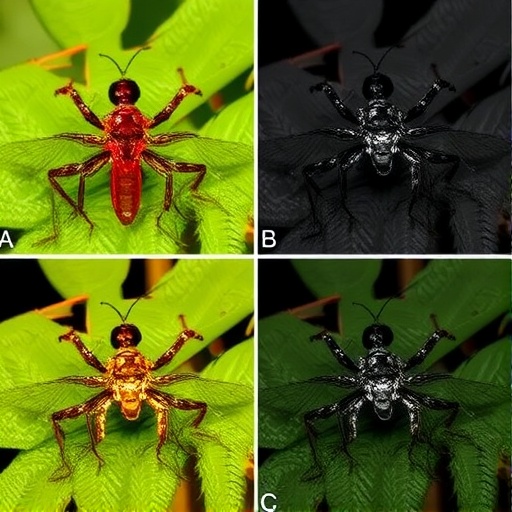In a groundbreaking study recently published in the journal Discover Animals, researchers have delved into the morphometric differences of Scartelaos histophorus, a fascinating species inhabiting various ecological niches within the Mekong Delta of Vietnam. This study highlights not only the morphological variations that exist among different populations but also the ecological implications of these differences, shedding light on how environmental factors drive evolutionary adaptations.
Scartelaos histophorus, commonly known as the mudskipper, is a unique fish species that has mastered both aquatic and terrestrial environments. Its ability to traverse mudflats while retaining necessary aquatic functions speaks volumes about the evolutionary pressures that shape its morphology. The researchers conducted thorough morphometric analyses across a range of populations in disparate ecological regions of the Mekong Delta, an area known for its biodiversity and complex environmental gradients.
The significance of this research is rooted in its exploration of phenotypic plasticity and the potential for local adaptation among the Scartelaos histophorus populations. Phenotypic plasticity refers to the ability of an organism to alter its morphology or physiology in response to varied environmental conditions. The study found notable differences in body size, fin shape, and other morphological traits that correlate strongly with the specific habitat types within the Mekong Delta.
Moreover, the findings underline the importance of microhabitats in determining the structural characteristics of mudskipper populations. Certain regions of the delta feature muddy substrates, whereas others offer more vegetation and structural complexity. The researchers found that populations residing in densely vegetated areas tend to have shorter, more robust bodies, which may confer advantages for maneuverability among dense roots and reeds. In contrast, those in more open, muddy flats developed longer bodies, likely aiding their capacity to swim efficiently in larger water bodies.
Another intriguing aspect of the study relates to the adaptive significance of these morphological traits. For instance, individuals with broader caudal fins demonstrated enhanced swimming abilities in turbulent waters, allowing them to exploit different feeding strategies. This trait could be a clear evolutionary response to varying predation pressures and resource availability in different habitats. The researchers emphasized that understanding these adaptive traits is integral to assessing how Scartelaos histophorus might respond to changes induced by climate change or habitat degradation.
Morphometric analyses were conducted using advanced imaging techniques and statistical methods, providing a precise measurement of various body components. The researchers applied landmark-based geometric morphometrics, which enabled them to capture shape variations beyond simple linear measurements. This approach offered insight into the complex shape adaptations that may not be visible through traditional means.
As the Mekong Delta faces increasing pressures from industrialization, agriculture, and climate change, the implications for local species are profound. The team highlighted the urgent need for comprehensive conservation strategies that account for morphological diversity and the ecological roles these variations play within their respective ecosystems. By understanding the adaptive traits of Scartelaos histophorus, conservationists can better predict how these populations will fare in a rapidly changing environment.
Through their meticulous fieldwork and data analysis, the researchers have opened up new avenues for future studies focused on evolutionary biology and conservation ecology. Their work enhances our understanding of how organisms adapt to their environments not just at a population level, but also across the wider Mekong Delta landscape. It highlights the intricate interplay between environmental factors and morphological adaptations, and how this can inform conservation efforts aimed at preserving the rich biodiversity of this critical region.
In a world increasingly influenced by human activity and climate change, studies like this remind us of the inherent resilience of nature. The ability of species like Scartelaos histophorus to adapt offers hope, yet it serves as a warning. As these fish navigate their ecological complexities, they also highlight the vital importance of protecting their habitats from overexploitation and environmental degradation.
This ground-breaking research serves as a catalyst for further investigations into the diverse biological responses of aquatic species to fluctuating environmental conditions. Future research could expand on these findings, exploring additional morphological traits and their functions in different species of mudskippers across other geographical regions.
The findings from this study are indeed critical not only for academic pursuits but also for practical applications in biodiversity conservation and habitat management. Protecting the unique environments of the Mekong Delta is essential for ensuring that species like Scartelaos histophorus can continue to thrive and evolve amid changing circumstances. As humanity grapples with the consequences of its actions, studies such as these illuminate the path to a more harmonious coexistence with nature.
In conclusion, the morphometric exploration of Scartelaos histophorus provides a fundamental understanding of the species’ adaptability and resilience. This research underlines the intricate relationships among morphology, ecology, and conservation, paving the way for future studies that can contribute to the sustainability of aquatic ecosystems in Vietnam and beyond.
Subject of Research: Morphometric differences of Scartelaos histophorus across ecological regions in the Mekong Delta, Vietnam.
Article Title: Morphometric differences of Scartelaos histophorus across ecological regions in the Mekong Delta, Vietnam.
Article References:
Van Ly, V., Dinh, Q.M., Van Hua, U. et al. Morphometric differences of Scartelaos histophorus across ecological regions in the Mekong Delta, Vietnam. Discov Anim 2, 93 (2025). https://doi.org/10.1007/s44338-025-00142-2
Image Credits: AI Generated
DOI: https://doi.org/10.1007/s44338-025-00142-2
Keywords: Scartelaos histophorus, morphometric differences, Mekong Delta, biodiversity, ecological regions, adaptive traits, climate change.
Tags: biodiversity in Mekong Delta ecosystemsecological adaptations of mudskippersenvironmental gradients affecting fish populationsevolutionary pressures on fish morphologyhabitat-specific morphological traitsimplications of fish morphology on ecologylocal adaptation in mudskippersMekong Delta fish speciesmorphological analysis of Scartelaos histophorusMorphometric variations in Scartelaos histophorusphenotypic plasticity in aquatic speciesresearch on fish species in Vietnam.





